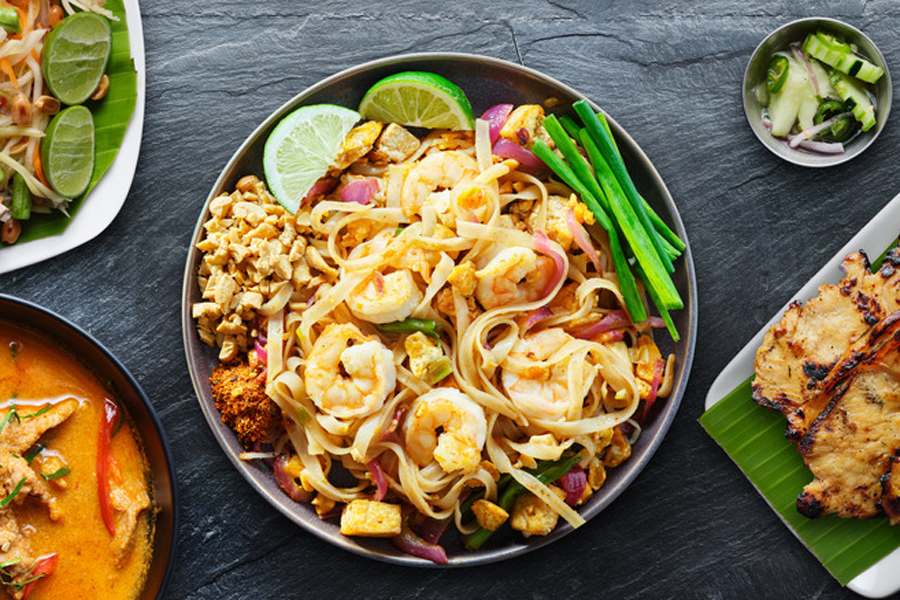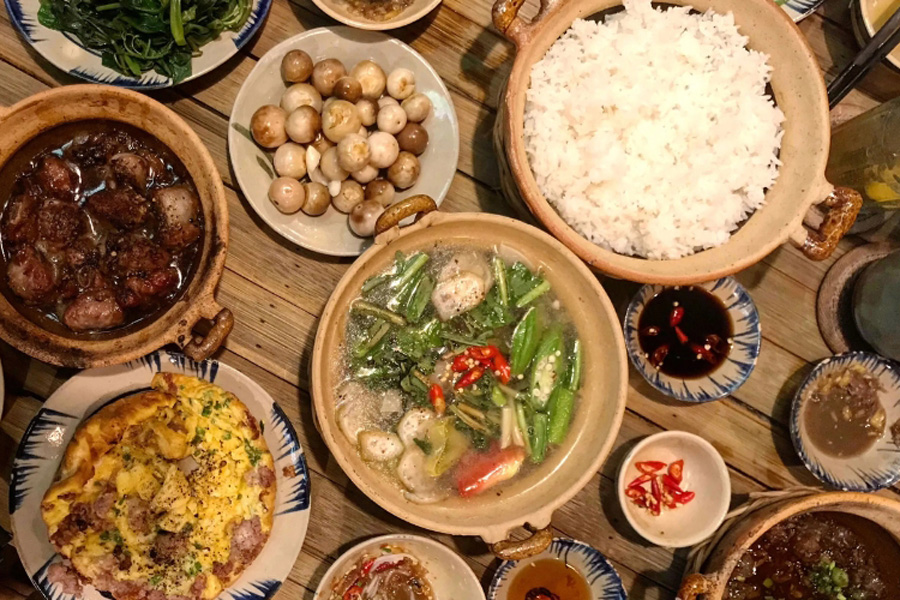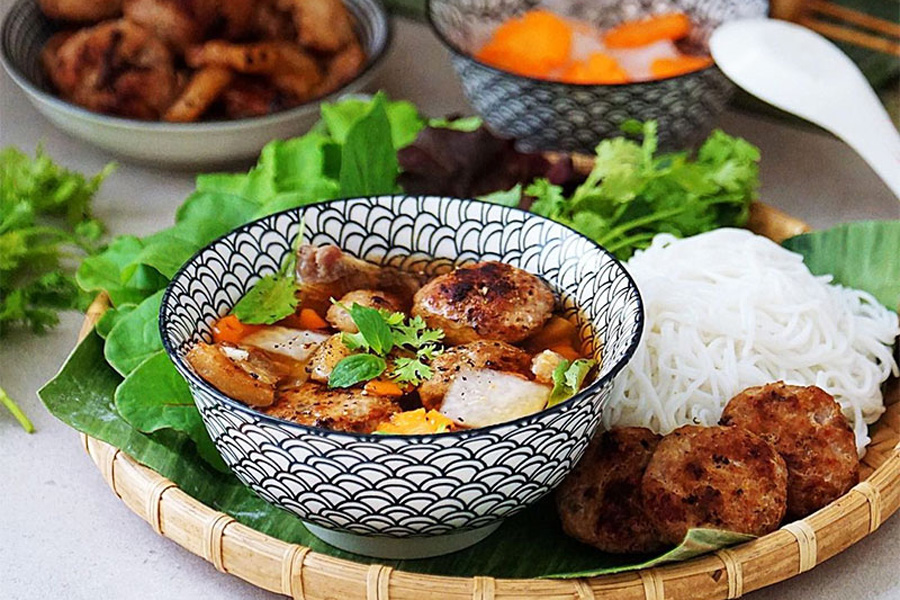
Thai and Vietnamese food represents the lively traditions of food originating from Southeast Asia; both have their characteristics. Whereas Thai food is renown for its strong flavors that combine sweet, sour, salty, and spicy elements, Vietnamese cuisine has opted for fresh ingredients with a more subtle flavor to bring out the natural taste of its herbs and vegetables, thus combining to provide a different kind of dining experience.
Thai Cuisine
Thai dishes are well-known for their bold and multi-dimensional flavors all combined into one dish: sweet, sour, salty, and spicy. It usually involves a balancing of contrasting flavors: sweet from palm sugar, the sour hint from lime or tamarind, and salty depth from fish sauce. Chili is a signature component, particularly fresh and dried chilies that give the heat to curries, soups, and salads.

Thai dishes (Source: Mashed)
Thai dishes are also very aromatic due to lemongrass, galangal, and kaffir lime leaves-the aromas that add a three-dimensional quality to food. From rich coconut curries to zesty papaya salads, every taste bud sings a symphony bold, invitingly balanced, energetic, and, at the same time, vibrant and comforting.
Vietnamese Cuisine
The other is Vietnamese cuisine, dishes intended for light, fresh, and natural flavors, which revolve around herbs and vegetables for that clean, fresh taste. It is herb-forward, with garnishes composed of cilantro, mint, and Thai basil. Most of the time, it would be served fresh to keep the aroma of each herb intact. Lime, fish sauce, and rice vinegar bring in gentle tang without overpowering each ingredient's natural flavor.

Vietnam dishes (Source: Vietnam Motorbike Tours)
The sweetness is usually subtle-from the sugar or caramelized onions-and then spice to taste, by the diner, with fresh chili or sauces on the side. Other dishes, like Pho or fresh spring rolls, bring this gentle balance into a far lighter and more delicate profile-one that really celebrates simplicity and freshness.
Thai Cuisine
Thai cooking is intensely based on a flashy palette of ingredients and condiments that add flavor to its dishes. Most dishes use coconut milk, which evokes a rich, sweet creaminess in curries like green curry and Massaman. The addition of lemongrass, galangal, and kaffir lime leaves creates a citrusy and fragrant aroma that is essential in soups like Tom Yum.

Ingredients in Thai food (Source: Learning to cook Thai food)
Fish sauce serves as the main salty condiment, used to add umami and depth. Other staple ingredients include nam prik or chili paste, tamarind for its sourness, and palm sugar that provides a natural sweetness. Fresh Thai basil and fresh cilantro are also fairly common additions in Thai dishes, creating aromatic depth so representative of Thai food.
Vietnamese Cuisine
Vietnamese dishes are cooked with fresh and simple ingredients to enhance the freshness in each course. It has fish sauce in the middle, which gives a light umami flavor, somewhat different in aroma and saltiness from Thai fish sauce. Herbs flow freely- cilantro, mint, Thai basil, and perilla leaves-often fresh for garnishes. Rice vinegar and lime lend their gentle acidity to the soups and salads without overpowering other flavors.

Vietnamese core ingredients and condiments (Source: Vietnam Coracle)
Instead of coconut milk, the base is usually broth in Vietnamese cuisine, for example, Pho, and a light texture is emphasized. The pickling of vegetables and nuoc cham-also a dipping sauce of fish sauce with lime, garlic, and chili-still remain extremely popular condiments to freshen and bring sour bites, allowing a subtle balancing of flavors.
Thai Cuisine
Accomplished by high heat, Thai dishes very often include fresh chilies, dried chili flakes, and spicy pastes like red or green curry paste. Dishes like "Tom Yum" (hot and sour soup) or "som tum" (spicy green papaya salad) have an intense, bold spice. Even milder Thai curries, such as green curry, can pack quite a punch because of the combination of chili and other spicy ingredients.

Spice Level (Source: iStock)
Thai dishes are supposed to be, theoretically, some sort of balance between heat and other flavors. Many dishes are constructed in order to emphasize spice as the main element of focus.
Vietnamese Cuisine
The food in Vietnam is usually milder, and the spiciness is mostly low and at one's liking. One would mostly serve dishes with fresh chili, chili paste, or sriracha sauce on the side for diners to help themselves according to taste.
With a few notable exceptions, such as "bun bo Hue" spicy beef noodle soup, most Vietnamese dishes are like "pho" and "goi cuon"-fresh spring rolls-offering delicate, balanced flavors with just a hint of spice, if at all.
Read more: Shocking Unique foods in Thailand for Adventurers
Thai Cuisine
In Thai cuisine, bold and flavorful techniques are used to cook food using high heat, which helps bring out the rich and layered tastes in its ingredients. Stir-frying is a quick, popular method of Thai cooking, with examples of dishes made from it such as Pad Thai and Pad Kra Pao, where high-heat woks lend a smoky flavor and pungent seasoning.

Thai cuisine cooking methods (Source: Riverside Thai Cooking)
Reduction plays an important role in Thai curries, such as green curry and massaman curry, where coconut milk meets spices to develop thick and complicated flavors over time. Deep-frying is used for crispy appetizers like spring rolls and fish cakes-satisfying textural contrasts to fresh herbs and tangy sauces they are served with.
Grilling meats, like satay and gai yang, in a marinade over an open flame creates that deep, smoky feeling so aptly combined with hot, sour dipping sauces to heighten the intensiveness of a dish. Each lends itself to showcasing Thai cuisine's knack for rich textures with bright, bold flavors.
Vietnamese cuisine
Food is fresh, tender, lightly prepared to accentuate the natural flavors of the ingredients in Vietnamese cuisine. Steaming is one of these light methods, which is used in dishes such as "banh cuon", or steamed rice rolls, to bring out flavors without adding oils or heavy seasonings.
Boiling and poaching are crucially central in the soups and broths that form the base of Vietnamese cuisine, from the original "pho" to "bun bo Hue". This process is accentuated by the ways in which ingredients are boiled with care in order to create a fragrant and yet clear broth that evinces the natural, innate essence of each component.

Vietnamese cuisine cooking methods (Source: Food & Wine)
Grilling likewise has its following, not least in dishes such as "bun cha", a certain kind of grilled pork with noodles, managing to add that smoky flavor without toughening the meat. It marries well with any fresh vegetables and herbs.
Wrapping and rolling are signature methods, particularly in "goi cuon", or fresh spring rolls, which wrap up herbs, shrimp, vermicelli, and rice paper into one refreshing and light dish paying homage to raw and vigorous ingredients. Together, these techniques typify the simplicity and harmony at the root of Vietnam's cookery.
Thai and Vietnamese cuisines boast unique dishes in which especial flavors, cooking techniques, and influences of culture are combined. Here is a glimpse of the popular dishes of each cuisine:
Thai Cuisine
Pad Thai: Stir-fried rice noodles with eggs, tofu, shrimp or chicken, and bean sprouts, flavored with tamarind paste, fish sauce, lime, and topped with crushed peanuts and herbs.
Green Curry: Silky curry prepared with green chili paste and coconut milk; other than vegetables, it mainly consists of Thai eggplant, chicken, or shrimp, and is seasoned with basil and lime leaves. Tom Yum: Spicy and sour soup prepared with lemongrass, kaffir lime leaves, galangal, and chili paste, generally with shrimp or mushrooms. The aroma and flavor are bold.
.jpg)
Green curry (Source: Heather Christo)
Som Tum (Papaya Salad): Refreshing, spicy, with shredded green papaya, tomatoes, green beans, and peanuts tossed in a lime juice, fish sauce, and chili dressing.
Massaman Curry: A mild to sweet curry from across the border of India, using coconut milk, potatoes, peanuts, and tender beef or chicken.
Vietnamese Cuisine
Pho: This is a noodle soup flavored with light and aromatic broth, rice noodles, thinly cut beef or chicken, and garnished on the side with fresh herbs, bean sprouts, lime, and chili. Banh Mi: Vietnamese sandwich-one of the sexy ones that involves a crusty baguette filled with meats like pork or chicken, pickled vegetables, cilantro, and spicy mayonnaise or pate.
Bun Cha: Traditional Hanoi dish made of rice noodles served with marinated pork that is grilled over an open charcoal burner with a variety of fresh herbs and is served with a light and sweet dipping sauce. It may come with fried spring rolls called Nem or Cha Gio.

Bun Cha (Source: kipor)
Bun Bo Hue: This is a spicy beef noodle soup originating from Hue-a broth flavored with lemongrass, shrimp paste, and chili, generally containing sliced beef, pork, and thick rice noodles.
Both cuisines offer different encounters. The dishes of Thailand are bold, intensive in flavor, whereas those of Vietnam speak to freshness and equilibrium, with ample herbs and light broths.
Thus, Thai and Vietnamese cuisines are outstanding: one with its peculiar flavor, kind of cooking, and cultural tint, and the other one with its light refreshing taste and freshness. Whether you're chasing sharp bright tastes of the Thai cuisine or light refreshing features of the Vietnamese dishes-it's all up to your taste. And to make an unforgettable gastronomic tour across the Southeast, try plunging into these vibrant cultures and mouth-watering dishes. Asia King Travel will make your adventure even more memorable by serving mouth-watering dishes to foodie travelers.
Read more: Thailand Tours 15 days